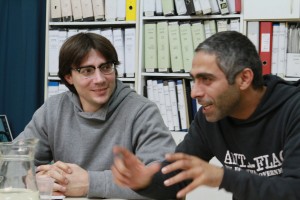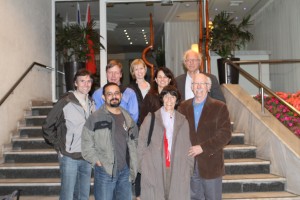Washington medical delegation to Gaza comes home
(This is Part 10 and the final story in this series. Gerri Haynes, a former president of Washington Physicians for Social Responsibility, has been sending back reports from inside blockaded Gaza. As she did twice before, Gerri organized a team of doctors and other health care providers to work in hospitals and clinics in Gaza in an effort to directly help the people there and to bring attention to the ongoing humanitarian crisis that the Israeli blockade has created.)
It’s snowing in New York. Our flight from JFK to Seattle has been cancelled and we are re-routed through Minneapolis. We sit in the snow-covered plane waiting de-icing and our turn at the runway – worlds away from Gaza, Bethlehem and Jerusalem.Our last day of this visit in Palestine/Israel moved us from Bethlehem to the Old City of Jerusalem and on to Tel Aviv to meet with members of Gisha and then Physicians for Human Rights, Israel. Before leaving for the airport, a young reservist lieutenant from the Israeli military joined us briefly. While on active duty, this thoughtful young woman had helped to expedite our permission to enter Gaza in October, 2009 and May, 2010. She is now enrolled in college. We thanked her for her help and wished her well with her studies.
Also, we visited with a young woman who has greeted us several times during our trips to the region – a woman we talk with in general terms about the views of moderate Israelis. Her views contrast with the views of Gisha and PHR, Israel. From representatives of these agencies, we heard strong Israeli concern about the situation in Gaza – recognizing that medical care is deeply compromised and that access to rebuilding the economy to afford better medical care is not now possible.
The collective punishment of the citizens of Gaza troubles nearly everyone we talked with in Israel. They indicate that the ethics of Israel are compromised by this imprisonment of 1.6 million people and are working to end the siege and find ways to assist the population.Tania, of Gisha, tells us that they are “working to give people the option to do what is right.” Neither Gisha nor PHR Israel holds political positions. Both agencies work on accessing assistance for the people of Gaza – with Gisha concentrating on movement of people and goods and PHR, Israel focusing on better access to medical care – for the people of Gaza and for immigrants to Israel.
Tania relates that Gisha provides legal and public advocacy i.e. provision of individual legal assistance with travel out of Gaza and public advocacy in the right/need to bring goods into Gaza. They are seeking to expand Israel’s criteria for movement.
In the past few years, Gisha has been successful in helping to bring some students out of Gaza to study – their publication of the ban on Gaza’s Fulbright scholars being unable to leave Gaza created awareness in the Israeli public and the ban was lifted.

Staff from Physicians for Human Rights Israel discuss the problems with getting increased medical care for Palestinians. (Bob Haynes photo)
After the Flotilla in May, 2010 disaster, Israel announced a loosening of the ban on the entry of construction materials. Since June, 2010, a high of 137 construction-material trucks/month are entering Gaza – but all of this material is designated for use by international agencies such as the UN. Cement, steel and gravel are still not available through the crossings between Israel and Gaza for public use. This affects housing, schools, business, and employment – life in general for the people of Gaza. On the export side, there is an agreement for 400 trucks/day to leave Gaza i.e. with produce. The average before the siege was 70 trucks/day. This had dwindled to zero. Since June, with Israel’s announced loosening of the siege, 4.5 trucks/day have been allowed to leave. Again, the context of the numbers is important to consider.
There is an announced increase in permits for business people to move back and forth between Gaza and Israel. In context, each time one individual moves in or out of Gaza, this movement is counted as a permit. So, for example, if one official from the UN goes back and forth to Jerusalem every day for one week, this is counted as five permits – giving the impression that the number of permits has increased well beyond the actual number of people receiving permits.
Most students still go through the arduous (and frequently failed) process of transit through Rafah to Egypt. Most movement through Erez to Israel is for patients with critical medical needs and their companion i.e. a baby and mother. General travel between Gaza and the West Bank is almost completely banned.
Physicians for Human Rights, Israel worked in and out of Gaza until prevented by the siege. Their partners in Gaza provide PHR with information about medical needs and they work to assist with movement of patients. They also focus on the need to improve the environment of Gaza – the impact of polluted water, air and soil on the health of Gaza is of continuing concern.
The ultimate solution to the critical problems facing Gaza, they maintain, will be freedom of movement, access to needed goods and services and the ability of the people of Gaza to heal and care freely for their own population.
Members of this delegation are available to give presentations about this work. Please contact Washington Physicians for Social Responsibility at 206-547-2630.
RSS feed for comments on this post. TrackBack URI

